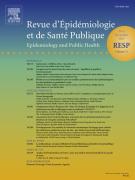Should psychological events be considered cancer risk factors? - 30/04/09
Existe-t-il un lien entre un événement psychique et le risque de survenue d’un cancer ?
 , H. Sancho-Garnier b
, H. Sancho-Garnier b  , M. Velten a, ⁎, c
, M. Velten a, ⁎, c 
Abstract |
Background |
The possibility that life events, personality, or depression can be considered cancer risk factors has been of great interest among the lay public and doctors.
Methods |
A critical review of different publications of meta-analyses, case–control studies, and cohort studies investigating a possible relation between the onset of cancer and life events, personality disorders, or depression is presented. Many studies have methodological limitations with possible bias, which may explain controversial results. We selected 32 studies from which conclusions can be drawn with the least amount of bias.
Results |
Eighteen out of 32 publications whose methodology permits unbiased interpretation show no link between psychological factors and the risk of cancer. Six publications show a significant link only in one or several subgroups and four surveys, three of which were published by the same author, show an inverse relation in gynecological cancers. As for life events and breast cancer, the results are slightly in favor of a positive relation in four studies; four others showed no relation, and one argues in favor of an inverse risk, which means a protective effect for this cancer. For life events and other cancers, studies show no relation, with the possible exception of cancers in women where endogenous estrogens can play a role (colon and endometrial cancers), where there is an inverse relation. No studies showed a significant relation between personality features and the risk of cancer. The studies of a possible relation between depression and cancer are controversial and no conclusion can be drawn.
Conclusion |
It cannot be confidently concluded that life events, personality features, or depression play a role in the onset of cancer.
Le texte complet de cet article est disponible en PDF.Résumé |
Position du problème |
L’idée d’un lien causal entre un événement psychique et le déclenchement d’un cancer est largement répandue dans le public et parmi les médecins.
Méthode |
Une revue des publications récentes concernant les études épidémiologiques consacrées à ce sujet a été effectuée, avec une analyse des différents types d’études (méta-analyses, cas-témoins, cohortes) sur le rôle des événements difficiles de la vie (stress), des troubles de la personnalité et de la dépression sur l’apparition des cancers du sein et d’autres types de cancers. Il existe en fait une grande hétérogénéité dans les études, avec des biais pouvant expliquer des résultats divergents. Nous n’avons retenu dans cette analyse que les 32 études permettant une interprétation la moins biaisée possible.
Résultats |
Au total 18 études sur les 32 dont la méthodologie a permis une interprétation ne montrent pas de lien entre facteurs psychologiques et risque de cancer, six autres ne montrent une signification que dans certains sous-groupes et quatre enquêtes, dont trois du même auteur, montrent une liaison inverse pour des cancers féminins. En ce qui concerne les éléments stressants de la vie et les cancers du sein, les résultats sont légèrement en faveur d’une augmentation du risque pour quatre études, mais sont contrebalancés par quatre études non significatives et une en sens inverse. Pour les éléments stressants de la vie en relation avec les autres cancers, les diverses études sont plutôt en faveur d’une absence de lien à l’exception, peut-être, des cancers ayant un lien avec l’environnement estrogénique chez les femmes (cancer du côlon et de l’endomètre) où le stress est protecteur. Aucune des études ne montre de lien significatif entre un trouble de la personnalité et le risque de cancer. Enfin, en ce qui concerne le lien entre dépression et risque de cancer, aucune conclusion ne peut être tirée.
Conclusion |
Dans l’état actuel des connaissances, il apparaît difficile de conclure à la responsabilité des événements stressants de la vie, d’une personnalité particulière ou d’une dépression sur l’apparition de certains cancers.
Le texte complet de cet article est disponible en PDF.Keywords : Cancer, Risk factors, Life events, Psychological stress, Personality disorder, Depression
Mots clés : Cancer, Facteurs de risque, Causalité, Événements de la vie, Stress psychologique, Personnalité, Dépression
Plan
Vol 57 - N° 2
P. e7-e16 - avril 2009 Retour au numéroBienvenue sur EM-consulte, la référence des professionnels de santé.

